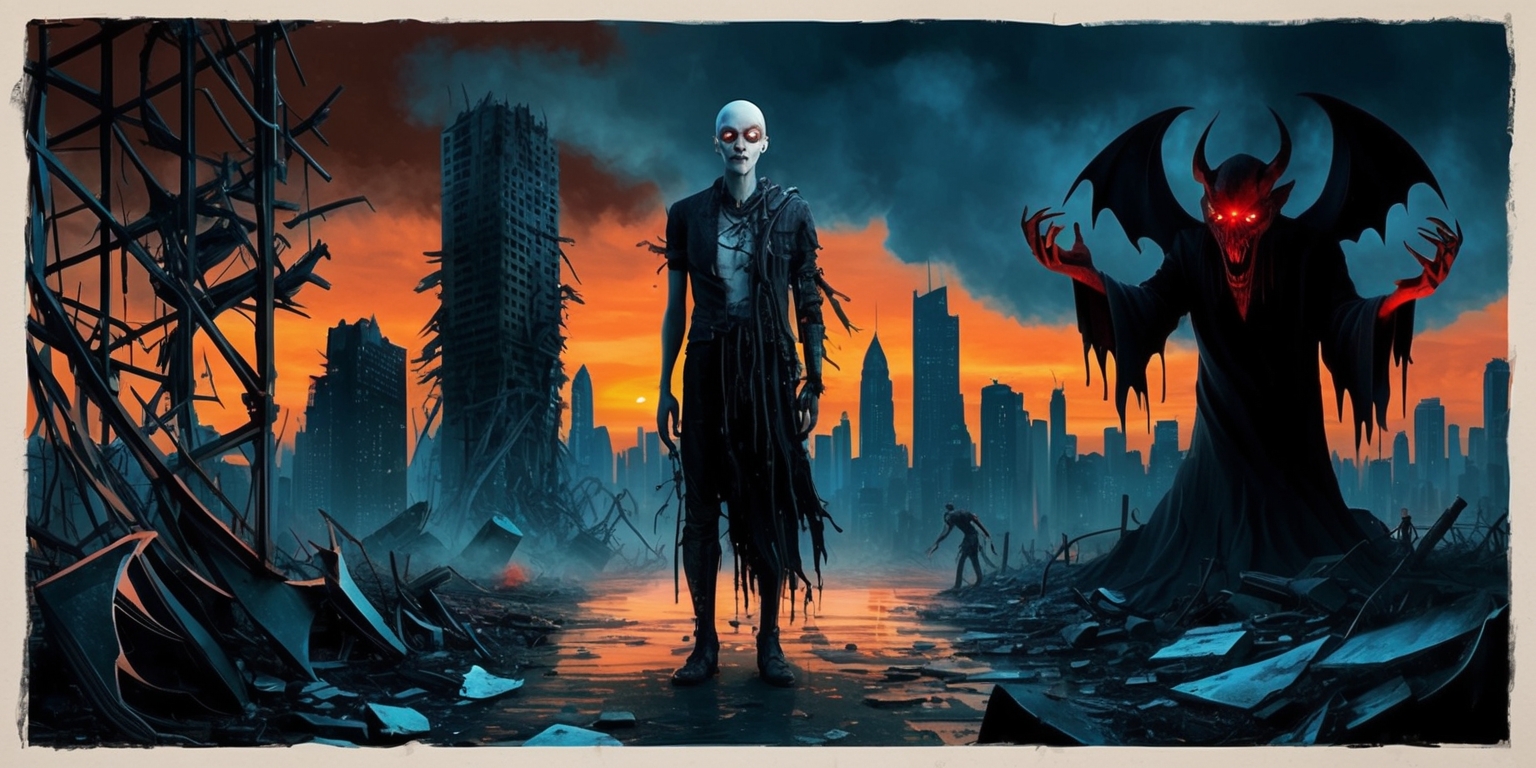Urban Decay and Demonic Bargains: A Fragmented Odyssey
- 2025-11-16
- 0 Comments

The game under discussion emerges as an attempt to blend narrative depth with a classic exploration framework, inviting players into a fractured world filled with supernatural forces and personal trauma. A narrative of loss and unexpected alliances unfolds amid ruined cityscapes. The storyline follows a young individual whose life is abruptly altered by a fateful encounter with a mysterious otherworldly presence. This presence forms an uneasy pact, intertwining memories and destinies and setting off a challenging journey across a world in decay. The narrative constructs and intertwining plot elements attempt to transcend traditional platform boundaries, yet the overall experience is weighed down by technical shortcomings and convoluted design choices.
Fragmented Memories and a Dark Pact
At the heart of the game’s narrative is the unusual partnership formed between a young protagonist and an elusive supernatural entity. The unfolding story weaves elements of anguish and hope as the protagonist, burdened by loss and bodily limitations, is offered a second chance at reclaiming her life through an unsettling deal. The demon-like presence shares recollections from a past steeped in darkness, allowing both characters to see fragments of memories that are as poignant as they are mysterious. The storytelling bears a resemblance to graphic novel panels, using sporadic memory sequences to gradually build a disquieting atmosphere. This melding of personal grief and fantastical intervention aims to create emotional engagement, even as the dialogue and narrative pacing occasionally feel overshadowed by technical missteps.
Labyrinthine Cityscapes and Confusing Navigation
The game places the player in a sprawling, decrepit urban environment that is as visually imposing as it is disorienting. The in-game map, Crafted to act as a navigational roadmap through the various districts of the city, struggles to accurately represent the intricately designed corridors and staircases. Although players are meant to chart their progress through the different sectors, the map’s oversimplified layout often leads to confusion during navigation. Without clear landmarks or intuitive signposts, the player finds themselves wandering a maze of broken skyscrapers and twisting passageways. This sense of disorientation not only disrupts immersion but also heightens the frustration encountered in discovering new areas, making progression feel more like an exercise in chance than a rewarding exploration challenge.
Eclectic Arsenal and Combat Mechanics
The combat system in this title is built around an assortment of unconventional weapons that range from everyday objects to creatively repurposed tools. Among these, an electric guitar and a yo-yo join a motley collection including a mobile device and a hockey stick. These items serve as the player’s tools for engaging with various adversaries, which themselves are reimagined everyday objects possessed by unknown forces. Although the inventive weapon choices add a touch of eccentricity, the combat quickly devolves into repetitive encounters that lack the dynamic feel necessary for sustained engagement. The enemies, despite their quirky designs, appear with unrelenting frequency, and their relentless respawns force the player into grueling cycles of seemingly interminable action. This monotonous repetition detracts from any thrill that the battles might have otherwise offered.
Fluid Movement and Frustrating Obstacles

The game attempts to offer a broad range of traversal mechanics to navigate its intricate world. Players are granted abilities such as air dashes, wall running, a slide kick, and the trusty grapple line, which progressively evolve as the narrative advances. However, the early stages of the game suffer from a lack of clarity regarding when and where new abilities are needed. This ambiguity in progression forces players into awkward scenarios where basic navigation is disrupted by design flaws. In several instances, the need to perform a specific, newly introduced move becomes painfully evident only after hours of frustration. The result is a juxtaposition between a set of versatile mechanics and poorly implemented checkpoints, leaving players in moments of helpless entrapment within the game’s environment.
Technical Hurdles and Performance Issues
A significant part of the experience is marred by technical shortcomings that affect both gameplay fluidity and overall immersion. Frequent loading delays occur between areas, resulting in jarring transitions where the player’s character appears to lag behind a collapsing backdrop. In addition, sporadic glitches with sound design, such as looping samples in the background, further disrupt the atmosphere of the game. These performance issues extend to severe frame rate drops in particular sections of the environment, suggesting that the game may not have been adequately optimized for all platforms. While the game is playable on devices like the Steam Deck, the necessity of lowering graphics settings for smoother performance highlights a persistent lack of polish in the implementation of its ambitious design.
Atmospheric Visuals and Rendered Environments
The visual aesthetics of the game present an intriguing blend of chunky, three-dimensional backdrops reminiscent of older handheld console titles. The lighting and fog effects, while aiming for a somber and reflective ambiance, seem to demand substantial processing power which results in performance compromises on less robust hardware. These environments are detailed in their desolation and evoke a sense of faded grandeur that aligns with the game's narrative of decay. Nevertheless, the overall graphical execution feels uneven; some settings display unexpected dips in frame rates or odd rendering glitches that distract from the intended mood. The ambitious artistic vision of a crumbling metropolis is evident, yet its full potential is undermined by technical limitations and inconsistencies across different hardware configurations.
Soundscapes and Unintentional Audio Glitches
Complementing the game’s visuals are its soundscapes, designed to evoke the eerie loneliness and foreboding danger that permeates the world. However, the audio experience is not without its own set of obstacles. Occasional glitches in the sound system, such as unintended interruptions and looped audio samples, disrupt the otherwise atmospheric background music and ambient sounds. The intended effect of creating a haunting, immersive experience is occasionally lost in these technical hiccups. Despite a carefully crafted auditory design that attempts to underscore the desolate mood of the ruined city, the sporadic sound issues pull the player out of the experience, highlighting once more an underlying instability in the game’s polish. The balance between creative sound design and technical reliability remains a challenging frontier for the developers.
Difficulty Settings and the Challenge Curve
The game offers multiple difficulty settings in a bid to appeal to a more diverse audience, but these options only marginally alter the underlying mechanics. On the easier setting, adversaries are designed to be less resilient, yet their frequency and aggressive patterns remain unchanged. This means that while the visual and health parameters might be tweaked, the relentless pace and challenging enemy encounters persist even in the more forgiving mode. On the normal setting, the steep difficulty curve becomes immediately apparent. Players must continually adapt to a barrage of obstacles where strategic retreat or cautious progression are rarely rewarded during early encounters. This careful calibration of difficulty, though seemingly aimed at inclusivity, ultimately reinforces the perceivable thin line between challenging gameplay and frustrating encounters.
Intertwined Narrative and World-Building
The game demonstrates an ambition to build a world where narrative and environment are inseparable elements of the player’s experience. Through fragmented audiovisual diaries and subtle cues, the remnants of a once-thriving metropolis unfold like pages from an ancient tome. The character interactions, though not driven by voiced dialogue, rely on textual narrative and in-game emails that occasionally add humorous or poignant contrasts to the grim setting. Despite the occasional moments where these narrative elements shine brightly, they often fall victim to the backdrop of convoluted objectives and technical missteps. The enticing premise of forging an alliance with a demonic force is delivered through an intricate tapestry of world-building, yet its impact is diminished by the incessant need to navigate an environment that seems deliberately obscured and overly complex.
Unstable Dynamics and Ongoing Frustration
The overall design of the game reflects a tension between ambitious ideas and the pitfalls of an incomplete framework. While each new mechanic promises to deepen the immersion and invite player exploration, the ongoing presence of bugs and glitches continuously hampers progress. Instances of characters becoming trapped within the game’s scenery or anomalies in dialogue cues contribute to an atmosphere that oscillates between excitement and frustration. The episodic narrative interlaced with unexpected technical failures fosters an experience where long sessions are punctuated by infuriating interruptions. The game’s effort to extend its longevity through complex, although at times chaotic, journey design often results in a sense of endless wandering, where the line between crafted challenge and unintentional difficulty blurs, leaving players with mixed emotions about the intended experience.






Leave a comment